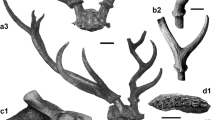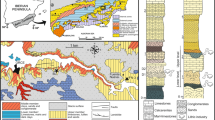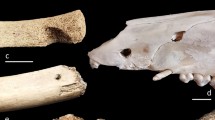Abstract
THE anthropologist, when studying excavated bone remains, often finds it difficult to distinguish specimens worked by hominids from those damaged by other processes. Although damage by carnivores and rodents is widely recognised as a potential source of confusion1, the role of herbivores (though well known to cattle and deer herders) is less well documented. In this communication, which originates from a visit to the Hardangervidda Mountains, Norway, in 1971, I describe some bones and antlers gnawed by Norwegian reindeer and Scottish red deer. It is clear that bones and antlers so gnawed can resemble human artefacts and have sometimes been mistaken for them.
This is a preview of subscription content, access via your institution
Access options
Subscribe to this journal
Receive 51 print issues and online access
$199.00 per year
only $3.90 per issue
Buy this article
- Purchase on Springer Link
- Instant access to full article PDF
Prices may be subject to local taxes which are calculated during checkout
Similar content being viewed by others
References
Sutcliffe, A. J., Nature, 227, 1110 (1970).
Blood, D. C., and Henderson, J. A., Veterinary Medicine, 3rd ed. (Baillière, Tindall and Cassell, London, 1968).
McBride, W. T., in Lea, T., King Ranch, vol. 2, 754 (Little, Boston, 1957).
Reynolds, E. B., et al., Bull. Tex. agric. Exp. Stn, 773, 3 (1959).
Hagerty, S., Country Life, 152, 693 (1972).
Fraser Darling, F., Natural History of the Highlands and Islands (Collins, London, 1947).
Fraser Darling, F., in The Future of the Highlands (edit. by Thompson, D. S., and Grimble, I.) (Routledge and Kegan Paul, 1968).
MacNally, L., Highland Year (Pan Books, London, 1968).
Teagle, W. G., Proc. zool Soc. Lond., 140, 337 (1963).
Millais, J. G., Newfoundland and its Untrodden Ways (Longmans, Green, New York, 1907).
Banfield, A. W. F., Bull. Can. Wildl. Mgmt (Series 1), 10 B, 1 (1954).
Kelsall, J. P., Bull. Can. Wildl. Mgmt (Series 1), 12, 1 (1957).
Kelsall, J. P., The Migratory Barren Ground Caribou of Canada (Queen's Printer, Ottawa, 1968).
Evans, E. M. N., E. Afr. Wildl. J., 8, 53 (1970).
Western, D., E. Afr. Wildl. J., 9, 156 (1971).
Wyatt, J. R., E. Afr. Wildl. J., 9, 157 (1971).
Riemann, H., Food-borne Infections and Intoxications (Academic Press, London and New York, 1969).
Smith, A. A., and Jones, T. C., Veterinary Pathology, 3rd ed. (Lea and Febiger, Philadelphia, 1966).
Kuss, S. E., Ber. Naturf. Ges. Freiburg i. Br., 59, 137 (1969).
Author information
Authors and Affiliations
Rights and permissions
About this article
Cite this article
SUTCLIFFE, A. Similarity of Bones and Antlers gnawed by Deer to Human Artefacts. Nature 246, 428–430 (1973). https://doi.org/10.1038/246428a0
Received:
Issue Date:
DOI: https://doi.org/10.1038/246428a0
This article is cited by
-
Antler cannibalism in reindeer
Scientific Reports (2020)
-
Can bone surface modifications help to identify livestock pens? The case of the Iron Age settlement of El Turó de la Font de la Canya (Barcelona, Spain)
Archaeological and Anthropological Sciences (2020)
-
Sequential Incisions on a Cave Bear Bone from the Middle Paleolithic of Pešturina Cave, Serbia
Journal of Archaeological Method and Theory (2018)
-
Bone surface modifications in zooarchaeology
Journal of Archaeological Method and Theory (1995)
Comments
By submitting a comment you agree to abide by our Terms and Community Guidelines. If you find something abusive or that does not comply with our terms or guidelines please flag it as inappropriate.



